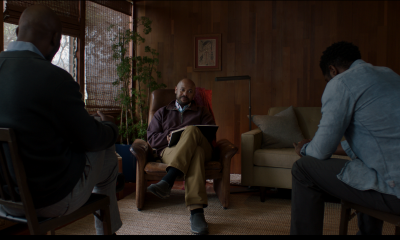Published
10 months agoon

“Nathan-ism“, directed by Elan Golod, is a documentary that transcends the surface to offer viewers a profound exploration of truth, memory, and the power of art.
At its core, it is a portrait of Nathan Hilu, an intriguing character with an obsessive passion for illustrating his life experiences. This film takes us on a journey through the intricate lines of Hilu’s autobiographical artwork, which carries the weight of his extraordinary past when he was a guard for Nazi war criminals during the Nuremberg trials.
The documentary’s strength lies in its ability to delve into the complex and often blurred boundary between fact and fiction in the narratives we construct over time. We witness how Hilu‘s storytelling has evolved into a collage, mirroring his artistry as he cuts, glues, and tapes memories together to make art pieces that tell stories that go deeper than you would imagine.
“Nathan-ism” is not just a film about art; it’s a journey into the world of the artist and his experiences. The documentary presents full galleries showcasing Hilu’s artwork, which some might label as primitive or amateur, but others recognize as an unfiltered and honest/purer form of expression. It underscores the notion that artistic expression can transcend rigid conventions and that art is the power of expression.
Through Hilu‘s drawings, the film humanizes historical figures like Hermann Goering, providing details of the man that he was and not just the harrowing acts of monstrosity he is known for.
Surprisingly, Hilu‘s somewhat doodled and cartoonish-styled images still can capture some horrifying undertones. In the detail, you can see the contrast between good and evil, right and wrong as well as victory and loss.
The documentary skillfully weaves together stories and conversations, talking about Goering‘s affection for his wife as well as even Hilu‘s interactions with Albert Speer, Hitler‘s architect.
The juxtaposition of these stories creates a tapestry of complexity, portraying Hilu as both a witness to history and a character who, over time, became entangled in his narratives.
The film leaves many of these stories open-ended, adding to the intrigue and inviting viewers to contemplate the shades of truth.
Where “Nathan-ism” truly shines is in its exploration of the challenges of verifying historical events and memories. It raises questions about the fragility of accepted truths, especially when faced with conflicting accounts. Golod’s quest to authenticate Hilu’s story becomes the film’s gripping narrative thread, transforming it into a captivating detective story.
While the documentary is largely successful in its exploration of these complex themes, it is not without its weaknesses. At times, the filmmaking becomes a bit forced, particularly in scenes where the emotional weight of an archivist seeking truth is emphasized through the music. These moments detract from the film’s ability to trust the audience’s discernment, and a more subtle approach could have elevated the storytelling.
The entire film in some ways also does seem a bit too dense, so much as though too much is going for the average person to be able to understand and appreciate.
However, these occasional missteps are minor quibbles in comparison to the overall impact of “Nathan-ism.” It is a powerful, provocative, and undeniably compelling work that transcends the boundaries of a simple character portrait. Good and his collaborators have managed to turn one man’s memories and art into a profound examination of the complexities of memory and the role of non-fiction filmmaking in the quest for truth.
In the end, “Nathan-ism” offers a portrait that goes beyond the bounds of what we see on a piece of canvas. It is the story of a man and his art, but it is also an exploration of how our narratives evolve and shape our understanding of the past. This film challenges the viewer to question not only the stories we are told but also how we remember and document history. Just like Hilu’s art, this film might not be appreciated by many.
It is a testament to the power of art and storytelling to both illuminate and obscure the truth, making it an essential viewing experience for anyone interested in the intricacies of human memory and the art of documenting history. “Nathan-ism” invites us to ponder the many layers of truth, memory, and the enduring impact of art.
I will score this 3 out of 5 stars.
Second on my list of addictions is Movies.. the only thing I could possibly love more is my Dearest Waakye lol. Nothing else does a better job of reminding me that ANYTHING is possible with the right amount of effort. I have great eye for details and flaws in scripts. Shallow scripts bore me. I am an avid reader. Your everyday Mr Nice guy. Always the last to speak in a room full of smart people. Half Human, half Martian but full MOVIE FREAK.



Short Film Review: ‘The Serena Variations’ – The Fine Line Between Genius and Madness


“Letters To Goddo” Lands Official Selection and Two Award Nominations at TINFF 2024


Short Film Review – “Get You Better” – Addiction, Desperation and Love.


Movie Review: ‘Protocol 7’ – A Not So Thrilling Dive into Vaccines and Corporate Fraud.


“Sins of a Father” – Debut short film by Nuek Hardy to Make World Premiere at Essence Film Festival.


Accra Indie Filmfest Announces Exciting Short Film Project Pitching Event












